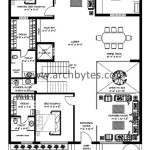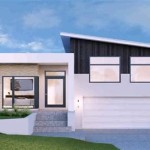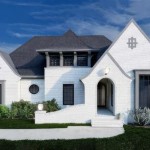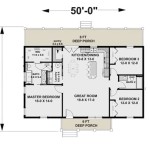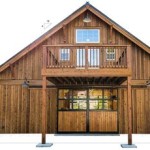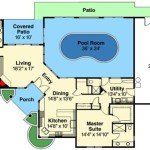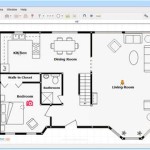House Plans: The Appeal of Simple Roof Lines
The roof, often overlooked, is an essential element of any house plan. It serves as the primary protection from the elements and plays a significant role in the overall aesthetic appeal. While complex roof designs, such as those incorporating multiple gables, dormers, and valleys, can create visually striking homes, there is a growing trend towards embracing simplicity. House plans with simple roof lines offer numerous advantages, ranging from cost-effectiveness to ease of maintenance and energy efficiency. These designs emphasize clean lines, minimizing architectural complexity and promoting a modern and understated elegance.
This article explores the benefits and considerations associated with choosing house plans featuring simple roof lines. It will delve into the various types of simple roof designs, including gable, hip, and shed roofs, and discuss how these designs contribute to affordability, structural integrity, and energy performance. Furthermore, the article will address the stylistic suitability of simple roof lines and how they can be integrated into a variety of architectural styles.
Cost-Effectiveness and Simplified Construction
One of the most significant advantages of opting for house plans with simple roof lines is the reduction in construction costs. Complex roof designs necessitate intricate framing, specialized materials, and skilled labor. The numerous angles, valleys, and intersections increase material waste and require more hours to install, resulting in higher expenses. In contrast, simple roof designs require less material, less complex framing, and can be installed more quickly. This streamlined construction process translates into significant savings on labor costs and material purchases.
For example, a gable roof, characterized by its two sloping sides that meet at a ridge, is one of the simplest and most economical roof designs. The straightforward framing process requires fewer cuts and joints, reducing the likelihood of errors and simplifying the construction timeline. Similarly, a hip roof, with its four sloping sides that meet at a ridge, is relatively simple to construct, although slightly more complex than a gable roof. The symmetrical design of a hip roof distributes weight evenly, enhancing its structural stability and minimizing the need for extensive support systems.
Furthermore, the simplicity of the roof structure facilitates easier and more accurate estimations of material quantities. This reduces the risk of over-ordering or under-ordering materials, which can lead to additional costs and delays. The ease of construction also makes it feasible for homeowners with some DIY experience to undertake certain aspects of the roofing project, further reducing labor costs.
Enhanced Structural Integrity and Durability
While aesthetically pleasing, complex roof designs can create structural weaknesses due to the numerous intersections and planes. These areas are inherently more vulnerable to water penetration and wind damage. The more intricate the roof, the greater the potential for leaks and structural failure. Simple roof lines, on the other hand, inherently offer greater structural integrity due to their fewer seams and straightforward design.
The elimination of complex features minimizes the points of potential weakness, making the roof more resistant to wind, rain, and snow. For instance, the continuous slope of a gable or shed roof allows water to run off easily, minimizing the risk of water damage and ice dam formation. Similarly, the symmetrical design of a hip roof provides balanced support and enhances its ability to withstand high winds. Fewer valleys and intersections also reduce the accumulation of debris, preventing potential drainage problems and prolonging the lifespan of the roofing materials.
The increased structural stability translates into lower maintenance costs over the life of the roof. Simple roofs are less prone to leaks, sagging, and other structural issues that require costly repairs. This makes them a particularly attractive option for homeowners who prioritize long-term durability and minimal maintenance.
Energy Efficiency and Climate Considerations
The design of a roof significantly impacts a home's energy efficiency. A well-designed roof can help regulate indoor temperature, reducing the need for excessive heating and cooling. Simple roof lines often lend themselves well to energy-efficient designs. For example, a steep-sloped roof can provide more attic space, which can be effectively insulated to minimize heat transfer. A shallower slope, on the other hand, can reduce the surface area exposed to the sun, thereby reducing heat gain in warmer climates.
Furthermore, simple roofs are often easier to ventilate properly. Adequate ventilation is crucial for preventing moisture buildup and regulating attic temperature. Proper ventilation reduces the risk of mold growth and helps to extend the life of the roofing materials. In colder climates, proper ventilation also helps prevent ice dam formation, which can cause significant damage to the roof and interior of the home. Simple roof designs, with their straightforward lines, generally allow for more efficient and less obstructed airflow, facilitating optimal ventilation.
The choice of roofing materials can further enhance the energy efficiency of a simple roof. Reflective roofing materials, such as light-colored shingles or metal roofing, can reduce heat absorption in warmer climates. Conversely, darker roofing materials can absorb more heat in colder climates, reducing heating costs. By combining a simple roof design with appropriate roofing materials, homeowners can significantly improve the energy performance of their homes and reduce their energy bills.
Stylistic Versatility of Simple Roof Lines
While often associated with modern or minimalist architecture, simple roof lines are remarkably versatile and can be incorporated into a variety of architectural styles. The key is to select the appropriate roof type and complement it with other architectural elements that reflect the desired style. For example, a simple gable roof can be adapted to a traditional farmhouse style by incorporating elements such as wide porches, dormers (although kept to a minimum), and clapboard siding.
Similarly, a hip roof can be used to create a more contemporary look by combining it with clean lines, large windows, and minimalist detailing. The symmetrical design of a hip roof also lends itself well to classical or traditional designs, where balance and proportion are key. A shed roof, with its single sloping plane, is particularly well-suited for modern or industrial-style homes, where its clean, angular lines create a distinct and contemporary aesthetic.
The choice of roofing materials also plays a crucial role in defining the style of a home. Traditional asphalt shingles are a versatile option that can be used to complement a variety of architectural styles. Wood shakes or shingles evoke a rustic and natural feel, while metal roofing can create a sleek and modern appearance. By carefully considering these elements, homeowners can create a home that reflects their personal style while embracing the benefits of a simple roof design.
Materials and Maintenance Considerations
The materials used in constructing a simple roof are crucial to its longevity and performance. Asphalt shingles are a popular and affordable option, offering a wide range of colors and styles. They are relatively easy to install and maintain, making them a practical choice for many homeowners. However, asphalt shingles have a shorter lifespan compared to other roofing materials.
Metal roofing, while more expensive upfront, offers superior durability and longevity. Metal roofs are resistant to fire, wind, and impact damage, and they can last for 50 years or more with proper maintenance. They are also energy-efficient, reflecting sunlight and reducing heat gain. Wood shakes or shingles offer a natural and aesthetically pleasing look, but they require more maintenance than asphalt or metal roofing. Wood roofs are susceptible to moisture damage and require regular treatment to prevent rot and decay.
Regardless of the roofing material chosen, regular maintenance is essential for prolonging the life of the roof. This includes cleaning the roof regularly to remove debris, inspecting the roof for damage, and repairing any leaks or damaged shingles promptly. Proper attic ventilation is also crucial for preventing moisture buildup and extending the life of the roofing materials. By investing in regular maintenance, homeowners can ensure that their simple roof provides reliable protection and enhances the value of their home for years to come.

Simple Rooflines 92024vs Architectural Designs House Plans

Exterior House Designs

Simple House Plans With Porches Wrap Around Porch

Modern Style Family Home With Graceful Gable Roofs Cool House Concepts

Stylish And Simple Inexpensive House Plans To Build Houseplans Blog Com

Simple Two Bedroom House Pinoy Plans

Small House Plan Ch18

Stylish Contemporary Home Design With Shed Roof Pinoy House Plans

Modern And Cool Shed Roof House Plans Houseplans Blog Com

Modern House Roof Designs With S Makanwalay

